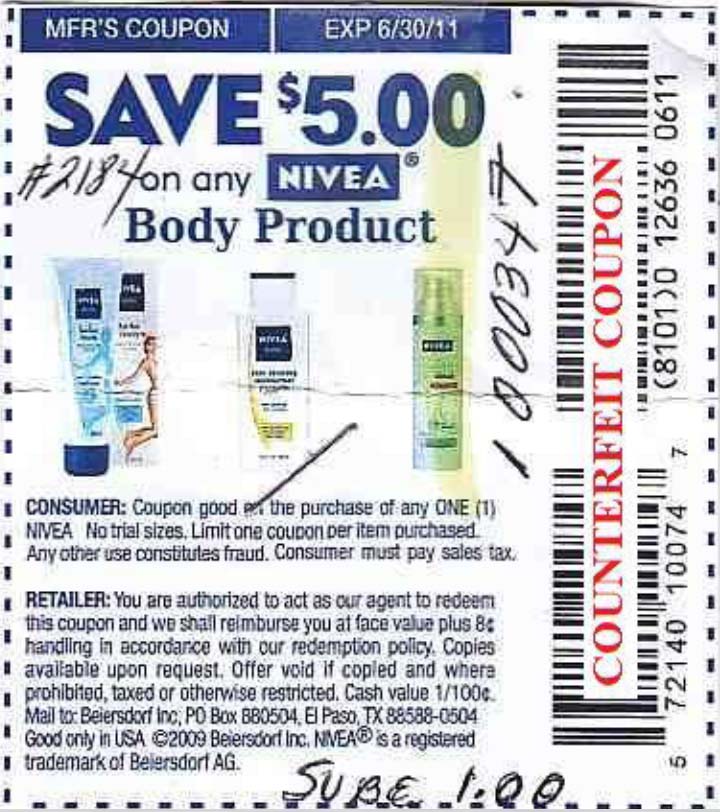Fraudulent coupons ultimately hurt you as a consumer because they discourage stores from accepting coupons and they discourage both stores and manufacturers from issuing coupons. The purpose of a coupon is for a store or manufacturer to offer you money savings on a specific product. When a fraudulent coupon is accepted by a cashier, then the store loses money because it can’t get the coupon reimbursed by the manufacturer or the store ends up giving you a discount it didn’t intend to give. Ultimately we as consumers lose because fraudulent coupon use affects the policies stores set for accepting coupons and influences the types of coupons issued in the future. I encourage you to read my tips below and visit the Coupon Information Corporation for more information.
My opinion is that all coupon users need to be aware of a few things to help protect themselves from being tricked into thinking a fraudulent coupon is a legitimate one. Not all cashiers are properly trained to spot fraudulent coupons, so my hope is that you will be smart enough to never even use one! Here are some things I want to share with you:
Is it too good to be true?
Then the coupon might not be a legitimate one. Question the source of the coupon – if you saw it posted on a message board or you received it from a friend via email then you need to really question whether the coupon is real and who the coupon was intended to be distributed to. Sometimes legitimate coupons are illegally distributed. An example of this is the coupon for a free Blockbuster rental (no strings attached) that was circulating by email (probably still is being circulated). It was just too good to be true so I did some research and found out that someone was trying to pass along their coupon from My Cokes Reward to everyone, when this coupon was intended for only one specific person and was one-time use.
A good coupon gone bad
Sometimes stores or manufacturers make mistakes and issue a coupon accidentally or the coupon gets distributed more widely than intended. This can result in the coupon issuer rescinding the coupon before the coupon expires. I’ve seen this happen with Nestle, Sears, Toys ‘R Us, and Target. The stores enforce this by simply not accepting the coupon. The Thomas the Train coupon was a great example of this – it seemed too good to be true, and Toys ‘R Us posted signs in their stores stating that this coupon was issued by mistake and was not being accepted. Target did the same thing with the $5 off $25 toy purchase coupon. They stopped accepting this printable coupon. Maybe the store didn’t make a mistake on a coupon, but if it gets illegally modified and then circulated on the internet (like the Target toy coupon), they may decide to stop accepting the original coupon along with the fraudulent modification in order to avoid confusion.
PDF and JPG Coupons
Sometimes these types of coupons are red flags as fraudulent ones. Any time you see one coupon appear multiple times on one page you’ve got to ask yourself if the manufacturer issued the coupon this way or if someone used PhotoShop to create this fraudulent coupon page? I do not post PDF or JPG coupons on my blog unless I know that they can easily be accessed by anyone directly through the manufacturer’s website. Even then, I prefer to send you to the website and tell you how to access the coupon yourself. There are legitimate coupons posted by manufacturers and stores in PDF or JPG form, but these coupons are often prime candidates for illegal modification and fraudulent distribution. Sometimes I will see a request (often by smaller companies) to please only print one coupon per household. Please respect these spoken limitations and do not abuse these coupons.
How many copies can you print?
Many manufacturers use technology to limit the number of times you can print a coupon and prevent hackers from modifying the coupon by never displaying an image of the coupon on your screen. That’s why you can only print one or two coupons per household or per computer. Manufacturer’s need to have some control over the coupons they issue, especially the high value ones. This is a wonderful thing because it hopefully prevents these coupons from being distributed in a manner beyond the manufacturer’s control. You’ll read me say “just hit the back button to print a second coupon” for those “bricks” coupons issued by Coupons,Inc. I get questions from readers asking me if this is a legitimate way to get a second coupon. The answer is yes because each of those coupons has a unique identification number on it, and the manufacturer intends for you to be able to print two (even though they may not advertise that you can print two).
Never photocopy or scan a coupon
Just a reminder that this is illegal to do. Some stores are having problems with people bringing in copies of coupons and have started requiring you to bring in the full sheet of paper with the URL on the bottom to prove you printed it and did not photocopy it. It’s usually easy to identify a copy because most printable coupons have a unique barcode or PIN on them – and copies look like copies. Theoretically, copied coupons can be tracked back to the computer where the original coupon was printed from. Never photocopy or scan a coupon because it’s illegal.
Don’t pay for coupons
Coupons are FREE and you should never pay for them. It doesn’t make sense to pay money for coupons and it makes you even more susceptible to unknowingly receiving fraudulent coupons. If you want to gather up more coupons, then there are other ways to do it without paying a “coupon clipping service” or buying them on eBay. It’s illegal to sell coupons and these services and sellers try to skirt around the issue. So I don’t recommend this as a good way to obtain legitimate coupons.
I’ve shared with you what I’ve learned from my couponing experience. Most coupons you will encounter are legitimate ones. Question any coupon that seems suspicious. For more information, please visit the Coupon Information Center. They are a not-for-profit association of manufacturers that issue coupons.
Do you have any more tips on how to spot or avoid fraudulent coupons?
![]()






I too, disagree about buying coupons from reputable sites…after all, there’s no difference in paying someone for their time to collect coupons you want, and buying a magazine or newspaper with lots of coupons you may not use. Buying multiple coupons from reputable sites is an economical way to add to your stockpile.
I disagree with not buying coupons from legit sellers. You are paying for their time to gather, clip and mail insert coupons to you, not paying for the coupons themselves. Since none of my grocery stores take any kind of internet printable coupon(even the excedrin ones that got mailed out on the special paper- nope, it looked like an IP so it was not allowed), I do have to go to other means of getting the coupons I need. And while it is the chain policy of the one chain grocery we have in our area to accept IP coupons, they do allow managers to deny them if there is a problem. Apparently, there’s a lot of cheating people in my area and they are not accepted at any of those stores in the area. All the local family owned ones do not accept IPs as well. So I have no choice but to use insert/from a magazine coupons.
Thanks for the tips. The other week I was chatting with an employee in frozen foods at my local Publix and was explaining about how I was using coupons on some BOGO items. The next time I was in the store, he told me that the coupons I’d used on one of the deals had turned out to be fakes! I was extremely upset and apologized and I did offer to reimburse the store for the value of the coupons but they said no, although I think they appreciated the offer. Fake coupons and mass photocopying of coupons and so on just hurt those of us who are trying to honestly save money. I’m really lucky because most people at my Publix know me and are really positive about my couponing and know I don’t try to “cheat the system” (which helps on those rare occasions when I accidentally try to use an expired coupon – why do they make the print so small?!) The store manager even asked me for some couponing advice for his wife! I’m seriously thinking about typing up a one-page tip sheet on couponing at Publix because so many people see my binder and stop me with questions and I end up standing there and writing down websites and explaining about manufacturers vs. store coupons and so on.
For Mitz who inquired about other ways to obtain coupons, and anyone else whose interested.
I have found several people at my workplace who have no interest in couponing and toss the coupon inserts every week. They are more than happy to bring them to me on Monday morning. I rewarded them this Christmas with a big basket of goodies from my “freebie” stockpile. I included body wash, lotions, soap, shampoo, dish soap, razors, chapstick, toothbrush and paste and lots of other stuff. They were thrilled and I’m assured of another year of coupons from them!
I don’t know if this has been mentioned or not, but I am sure that there are a lot of you who already know. But the magazine All You has a ton of coupons each month in it. There website even has a bunch as well, AND has a daily freebie you can sign up to get. They will send you an e-mail to see the freebie, too. Sometimes it something that has already been offered or posted on here or other sites, but still. Good deals!
I agree with everything you said except the coupon clipping services. There are just a handful that are legit, and I have used them. Like Gwen said, you are paying for their time to sort, clip, and mail. That is totally legal. They have never sent me full tearpads or anything like that (that would infuriate me) – they have a database and you just pick what you need. This is especially helpful if you really use a lot of something and can get a $1 off coupon for $.07 cents. I just don’t see anything wrong with this. But I don’t order 200, I might order a variety for a total of 20. I use what I need to buy without hoarding or over-stockpiling. I think those that clean out the shelves with the multiple coupons should be the ones who are banned. A limit of X should be allowed per day for a certain coupon.The ebay stuff is wrath with fraud and I stay away from that. Just my opinion. Thanks for the lesson – I tell everyone I know that copying is illegal and if they are going to do that, they are going to pay in the long run when the stores stop taking our coupons as so many have said.
I for one do not like to print coupons off internet, unless they are some really great ones. Because I have had soo much trouble with them. We have a number of stores in our area who refuse internet coupons. I won’t shop at a certain store for that reason.
it is illegal to sell coupons, but it is NOT illegal to charge people for the time it takes to find, sort, clip, and ship them to you.
My local Hyvee stopped accepting ”free” coupons that I you can get in the mail when a company has a promotion. It does not even matter if it comes direclty from the company they will just not accept it. I guess I have to find another store when I get my Herbal Essence coupon in a few weeks :)
I know that everyone probably already knows this but…….
Our local Walmarts here in SC only accept an internet coupon if it will scan. So don’t get upset if your coupon won’t scan and your cashier says she can’t take it. She is just doing her job.
Interesting. I didn’t know that it was illegal to sell coupons, but that makes sense. Here’s to good couponing!
I went shopping at Walmart last week using my printed coupons from coupons.com at first the cashier told me she was not going to take them because of the fraud on printed coupons. It did upset me at first because I had just used them the week before. The cashier asked the head cashier and they took them.
thank you! I always use coupons ethically. I cannot stand deal or coupon sites that do not promote these efforts (and there are a fair few!). That is why i stop in here and not at those ones. I don’t give them my business (clicking on ads, signing up through them, etc) because that promotes bad coupon users everywhere!!
Thanks for the info and tips!
I don’t have any more advise on how to “spot the not”. I would just like to say that there are several stores in my area that no longer accept printed coupons. The reason they gave was a very specific one….The Dorito coupon that went like wildfire. Hopefully there is way we can regain the trust of our grocery stores!! As a stay-at-home mommy of 5, I use these coupons as a way to compete with the rising cost of food (as does most everyone else). I don’t work so I HAVE to find ways of saving money and people who do these types of things may get a small something in the begining, but people like me pay the highest price in the end. Thank you for posting this.
My local Giant Eagle has already stopped accepting Buy one get one Free and Free coupons printed from hte internet because of illegal photocopies. I don’t think it’s right because an honest customer like myself is loosing out! But I understand that the store is just trying to prevent loosing money!
You say that there are other ways to get coupons without using coupon cutting services or eBay but you don’t say what those ways are. Could you give more info?
Yes, I’ve got another post on expanding your coupon sources that I’ll try to post next week. Best source is the Sunday paper but also magazines, printables, packaging, request by mail, in-store Catalinas.